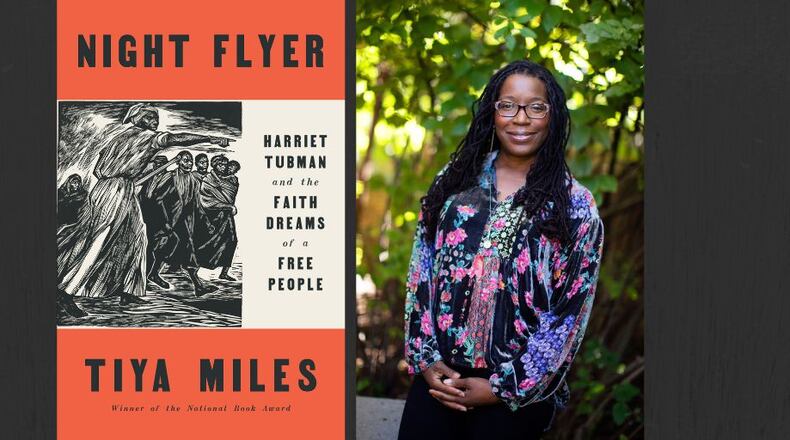National Book Award winner Tiya Miles has delivered an innovative vision of Harriet Tubman’s life in her groundbreaking biography “Night Flyer: Harriet Tubman and the Faith Dreams of a Free People.” Pushing past the mythology of Tubman as the “hyperracial oddity” that previous biographers have portrayed, Miles takes painstaking care to present Tubman as a God-fearing freedom fighter in all her life stages. From an adolescent who survives a head injury to a woman who suffers greatly while toiling to free others from enslavement, Tubman was a mortal woman who relied on her faith and connection to nature to persevere.
“Night Flyer” is the first work in “Finding Your Roots” TV host Henry Louis Gates Jr.’s intellectual megaproject called Significations. In partnership with publishing giant Penguin Random House, Gates is spearheading a collection written by contemporary authors who analyze the life and significance of Black cultural figures through a modern lens. Over two-dozen pairings have been announced, with exciting works such as Imani Perry reflecting on Stevie Wonder and Roxane Gay exploring Beyoncé slated for the future.
In Significations’ first installment, Miles has constructed a “faith biography” to frame her exploration of Tubman’s remarkable life. Miles confesses in “Night Flyer’s” preface that before she began researching Tubman, the famed emancipator seemed “prepackaged in a box of stock stories and folksy sayings.” Seeking to portray “the woman behind the cardboard cutout,” Miles begins by establishing Tubman as a deeply spiritual human.
Harriet Tubman entered the world in 1822 as Arminita “Minty” Green-Ross, one of nine children born to a married couple who were enslaved on neighboring plantations in Dorchester County, Maryland. Under slavery laws, Harriet “Rit” Green and Ben Ross had no control over their lives or their children’s futures.
Miles paints a heart-rending picture of Tubman’s early years, envisioning her struggle to care for her siblings and perform household and farm labor from her youngest days. Citing the twin forces of threat and neglect as foundational experiences that shaped Tubman’s character, Miles suggests that feelings of insecurity, shame and purpose primed Tubman to endure the hardships she would later face.
In Miles’ account, Tubman clings to her faith to survive tough times. While rooted in Christianity, Tubman’s religious exposure expanded beyond traditional Christian teachings to include beliefs shared by other enslaved people. A quest for justice, an innate thirst for freedom and “a belief in second sight and the use of natural protections” gathered from West African and Native American traditions rounded out her spiritual worldview.
In the author’s note, Miles asserts that “Night Flyer’s” difference from previous Tubman biographies is her effort to place Tubman in a broader “Black female faith culture.” As she moves through Tubman’s life, Miles continuously references a collective of influential women who share Tubman’s “deep religious conviction and took radical action to preach and act on what they believed.”
By drawing parallels between Tubman’s experiences and those of the preachers Old Elizabeth, Jarena Lee, Zilpha Elaw and Julia Foote, Miles pushes past the notion of the “magical Tubman” by placing her in the company of like-minded contemporaries.
Old Elizabeth and Tubman were both born into slavery. They experience early separation from their parents and are sent to work on neighboring farms as adolescents to diversify their skill sets. Both flee in the night, return to their mothers and are forced back to their foreign environments. Ultimately, they seek to escape their enslavement through divine intervention and both are successful in actualizing freedom for themselves and others.
A traumatic brain injury in adolescence leaves Tubman with epileptic seizures and is the source of much of her suffering. Miles chronicles how Tubman is forced to work following her injury, existing in a state of misery so horrific she only survives by using her hardship to fuel her spirit. Her seizures provide a vehicle for the voices, visions, dreams and conversations with God that feed her quest for freedom. These incidents also contribute to Tubman’s supernatural mythology.
The concept of suffering leading to an expansion of faith is also experienced by Tubman’s cohorts. Zilpha Elaw miraculously survives a fall, resulting in her ability to have direct conversations with God. Losing an eye compels Julia Foote to exist in “a secret place of prayer” that leads to deep spiritual conversion. And Jarena Lee believes God spoke to her in a series of dreams that foretold of her failing health. Each experience fortifies these women for their future work.
Tubman’s faith may have provided the mental fortitude to break free from the “demon called Slavery.” But how does she physically survive circumstances that killed many others, especially once she achieves her own freedom and repeatedly returns to inhospitable territory to aid those still enslaved?
Miles asserts it’s Tubman’s connection to the natural world that fuels her physical fight. A youthful Tubman is forced to toil in harsh conditions. This develops into a preference to work outdoors. Eventually Tubman recognizes the potential for land and water to “provide sustenance or refuge.” As with the aforementioned freedom fighters, Tubman considers nature a tool God provides to facilitate her autonomy.
Harriet Tubman was much more than a mythical Grandma Moses who led the enslaved to freedom. She was a human being who used the constraints of her life to fuel her resistance. Through Tiya Miles’ meticulous research and an unwavering focus on Tubman’s humanity, “Night Flyer” has transformed a fantastical figure from a bygone time into an accessible, modern-day inspiration.
NONFICTION
“Night Flyer: Harriet Tubman and the Faith Dreams of a Free People”
by Tiya Miles
Penguin Press, 336 pages, $30
About the Author
Keep Reading
The Latest
Featured



